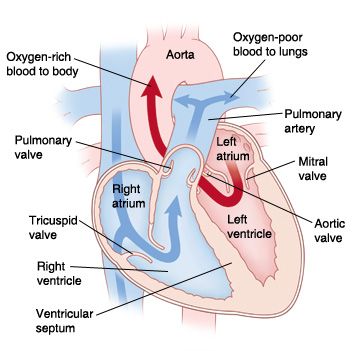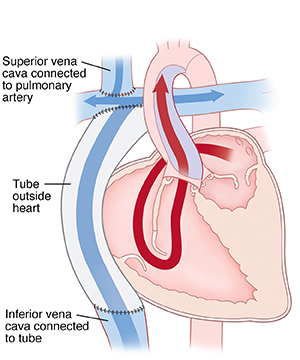In hypoplastic left heart syndrome (HLHS), blood returning from the lungs must flow through an opening between the right and left side of the heart. The right ventricle pumps the blood into the pulmonary artery. Blood reaches the aorta through a patent ductus arteriosus.
Your child has a defect in the heart called a hypoplastic ventricle. This means that one of the ventricles is either too small or absent. The most common treatment is heart surgery. It is often done in three stages. The surgery does not fully repair the heart problem. But it can relieve symptoms. And it can increase your child’s chances to live a more normal life. This sheet helps you understand the surgery that is done during stage III of treatment. Your child’s health care provider can tell you more as needed.
The goals of heart surgery for a hypoplastic ventricle
-
Stage I. Make the single working ventricle the main pumping chamber of the heart and provide stable blood flow to the lungs. This will provide blood to both the lungs and the body.
-
Stage II. Decrease the workload of the single ventricle. This reduces the mixing of oxygen-poor and oxygen-rich blood.
-
Stage III. Separate the circulation of blood in the heart. This is so very little oxygen-rich and oxygen-poor blood mix.
What are the risks and possible complications?
Risks and possible complications include:
-
Abnormal heart rhythm.
-
Problems in the lungs.
-
Heart failure.
-
Infection.
-
Bleeding.
-
Problems with the nervous system, such as seizures or stroke.
-
Abnormal buildup of fluid around the heart or lungs.
-
Blood clot.
-
Death.
Stage III: The Fontan procedure
This surgery is done when your child is 2 to 4 years old. Your child may stay in the hospital for 1 to 2 weeks. This part of the surgery is done to separate the circulation of blood in the heart. This is so oxygen-poor blood does not mix with oxygen-rich blood in the single ventricle. The surgeon will do one of these two repairs:
-
Intracardiac Fontan. The inferior vena cava (IVC) is a large blood vessel. It brings oxygen-poor blood to the right atrium. A tube is built within the right atrium to make a baffle (tunnel). This is so that blood flows from the IVC directly to the pulmonary artery. This sends blood straight to the lungs to get oxygen. Sometimes, a small hole is left in the tunnel (fenestration). This hole acts like a pop-off valve, preventing pressure from building up in the lungs too much after surgery.
-
Extracardiac Fontan. The IVC is sewn into a tube that is put outside the heart. The tube goes straight to the pulmonary artery. This lets oxygen-poor blood flow straight to the lungs to get oxygen. A fenestration may also be used in this case.
When should I contact my child's doctor?
Contact your child's provider right away if:
-
There is more redness, draining, swelling, or bleeding at the incision site.
-
Your child has a fever 100.4°F (38°C) or higher, or as advised by your provider.
-
Your child is irritable.
-
Your child has trouble feeding, poor appetite, or not gaining weight.
-
Your child has belly pain.
-
Your child is tired a lot.
-
Your child has a cough that won’t go away.
-
Your child has nausea or vomiting that continue.
-
Your child doesn't seem to be getting better.
-
Your child has cyanosis that gets worse.
Call 911
Call 911 right away if:
-
Your child has trouble breathing or is breathing fast.
-
Your child is not responsive.
-
Your child has an irregular heartbeat.



